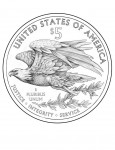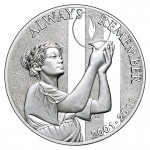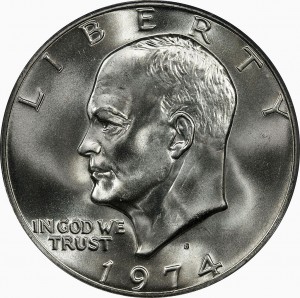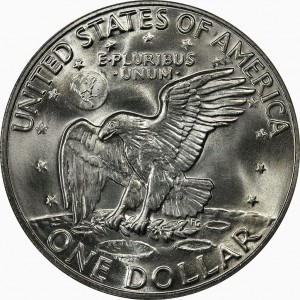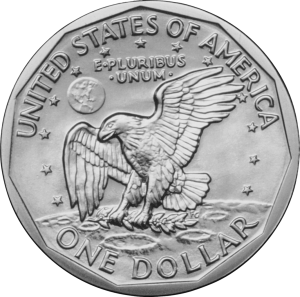One more bill from the 116th Congress
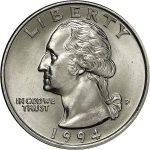 With the 116th Congress gaveled to a closed, the only numismatic-related bill left to watch is H.R. 1923, Circulating Collectible Coin Redesign Act of 2020. The House of Representatives agreed with the Senate’s amendment on December 31, 2020, and sent it to the White House on January 1, 2021. The president has until January 13, 2021, to sign the bill into law. If he does not sign the bill, it becomes the victim of a pocket veto.
With the 116th Congress gaveled to a closed, the only numismatic-related bill left to watch is H.R. 1923, Circulating Collectible Coin Redesign Act of 2020. The House of Representatives agreed with the Senate’s amendment on December 31, 2020, and sent it to the White House on January 1, 2021. The president has until January 13, 2021, to sign the bill into law. If he does not sign the bill, it becomes the victim of a pocket veto.
- H.R. 1923: Circulating Collectible Coin Redesign Act of 2020
Sponsor: Rep. Barbara Lee (D-CA)
Passed the House of Representatives — Sep 22, 2020
Passed the Senate with amendments — Dec 17, 2020
LAST ACTION: Presented to President. — Jan 1, 2021
For a description of what coinage is included in H.R. 1923, see the September 2020 Numismatic Legislation Review.
Introducing the new money.org
 The future of the American Numismatic Association began on Friday, August 1 with the launch of the new ANA website!
The future of the American Numismatic Association began on Friday, August 1 with the launch of the new ANA website!
What are you talking about, the ANA has a website.
This is the NEW website with a new look and new technology.
But it’s the ANA, the website must be like putting lipstick on a pig.
No, it isn’t. The website is a complete re-engineering of the ANA online and digital assets to move the ANA into the present and position the organization for the future. First, the computers that the site is running on are no long in the headquarters in Colorado Springs. The new computers are located in a world-class data center run by Level 3 Communications, one of the leading service providers in the industry. Level 3 has an impeccable reputation for being able to manage computers and networks that anyone with a technical background working with the ANA on this project did not question this as the choice for the hosting of the new website.
Supporting the website is a new membership management system that the staff in Colorado Springs has reported as being easier to use and makes it easier to support the members. Rather than having to work around the problems and mistakes of the older software, the new software allows the ANA to update its procedures to better serve the members.
Finally, the website is supported by a new content management system (CMS) that makes it easier to add and change information as necessary. A CMS is the software stores the information you see in your browser and is served up to you on demand. CMS helps keep data in a way to allow it to be more easily managed so that it can be displayed in the browser in a way that will help you stay engaged.
While it looks like the ANA just changed the look of their website, everything about the ANA web presence has changed. It is a new service that will allow the ANA to introduce and engage more members as the world shifts to being online.
Yes, it looks nice, but are they introducing anything new?
Looking nice is important but it is only the beginning. The first application that has been rolled out is the social engagement features. There’s a place to post articles to share with the community, a forum to chat with other numismatists, and a place to show off your collection. There are also ways to interact with the ANA, pay your dues, and read the online version of The Numismatist.
Social media already exists and several forums where people can interact. What makes this so special?
First and foremost, rather than trying to interact with Internet trolls you will be interacting with fellow members of the ANA. While they may decide to participate using an alias, you can be assured that only ANA members will be allowed to register and us the ANA’s system.
So what’s the big deal? There are other sites with numismatic content.
Remember those commercials that touted “membership has its privileges,” this is only the beginning of what will be available exclusively to ANA members. One of the first socialization features is for contributors to earn “coins” or electronic awards for contributing to the numismatic community. Right now, the coins only provide ANA members bragging rights, but in the future, the coins will include potential prizes, discounts with ANA member establishments, and other incentives.
So the ANA has turned the website into a game?
The ANA has turned their website into a one that is more engaging for the membership and to attract new members. The world is moving online and in order for the ANA to serve all members, the ANA has to embrace and expand its online presence. The ANA Board of Governors’ goal is to make money.org be the numismatic hub of the community. The place to go where is anyone has a numismatic question, they can start with the country’s premier numismatic organization.
Well… it looks interesting. I’ll give it a look and see what happens.
I hope everyone gives it a look and provides feedback to the ANA. A lot of people really did a lot of work getting this first release completed on time and on budget. And not only that, the areas where the ANA holds and processes personal information was secure from the beginning because one of the site’s advisors (me) is an information security professional in real life. There was no way I was going to jeopardize my professional reputation by being involved with something known to have security problems. Besides, as an ANA member, they are storing my information and processing my credit card, too!
Everyone please go to money.org and interact with the website. Engage in the forums. Let us know what you think!
Summary of July coin-related legislation
While doing my monthly review of the numismatic-related political news for the Gold & Silver Political Action Committee, I came across a bill that seems to have missed the numismatic press. One reason it was missed might be that the provisions are buried in a larger bill and has a name that might not be as noticeable. However, there are two issues buried in a larger bill. The bill is as follows:
H.R. 5196: Unified Savings and Accountability Act (or USA Act)
Buried within the bill are two provision that may be of interest to collectors.
If passed, Section 203 would require that the U.S. Mint stop striking any coin that costs more to manufacture than its face value four years following the passage of this bill. Using current standards, the U.S. Mint would be required to stop producing one- and five-cent coins by late 2018 because they cost more than their face value to produce. One of the problems with this bill is what would happen if the price of copper and zinc, the drivers in the price of both coins, were to fall and the costs were reduced to below face value? Would the coins be struck again?
As the title suggests, Section 205 will replace the one-dollar Federal Reserve Note with the dollar coin. The section begins with requiring the Federal Reserve to “sequester” Susan B. Anthony dollars to remove them from circulation. There is a provision for their value as numismatic collectibles.
The plan to remove the $1 FRN is just to stop issuing the notes and replace them with coins as the notes come out of circulation after a one-year educational period. The Federal Reserve would continue to use the notes alongside the coins until 600 million coins are in circulation or for four years, whichever comes first. The bill allows the Bureau of Engraving and Printing to continue to print the $1 FRN for collectors.
Given the current state of congress, the likelihood of this bill passing is slim-to-none, and, as a friend liked to say, “Slim just left town.” Some of the other provisions of this bill might be introduced into an omnibus budget bill following the November elections, but it is doubtful that these sections will make it past this introduction.
Then again, who knows? Congress has surprised us in the past!
Sales Limits on Kennedy gold
 According to the U.S. Mint:
According to the U.S. Mint:
Because of the expected overwhelming response, dialog with our customers and many others interested in the 50th Anniversary Kennedy Half-Dollar Gold Proof Coin, the United States Mint is reducing the over-the-counter purchase limit to one unit per customer.
This change in the purchase limit will give more members of the public an opportunity to purchase this popular coin, essentially doubling the number of customers able to purchase it. The number of units available at each retail location (Philadelphia and Denver facilities, Washington, D.C., headquarters and Chicago ANA World’s Fair of Money) will remain the same. There will be 500 units available initially at each United States Mint location (Philadelphia, Denver and Washington) and an additional 100 units per day for the first three days after the product launch. There will be 2,500 at the ANA, 500 available per day of the convention.
The household ordering limit of five will remain the same.
UPDATE: The price effective for the August 5 opening day of sales for the 2014 50th Anniversary Kennedy Half-Dollar Gold Proof is $1,240. See the U.S. Mint’s online catalog for more information.
NOTE: Usually I do not post press releases directly since there are many other places to see these announcements. Since there has been a lot of interest in these coins, I am posting this as a service to my readers.
After further review…
These are fair criticisms. I did not attend the April meeting and Chairman Marks provided good introductory explanations prior to the discussion. Before commenting, I should have looked at the previous meeting’s notes which are available on the CCAC website. In retrospect, my criticism about the program was probably not fair. However, it is fair to question the direction the CCAC is proposing.
The other criticism that I will alter but not retract is the one when I said there was an “over-the-top cult-like patriotic gushing by some of the members over the proceedings.” Rather, what I should have said is that the CCAC was very full of themselves to the point of being too self-congratulatory and overblowing the self-perceived importance of what is being proposed.
What is being proposed is a medals program that Marks tentatively called an “American Liberty Silver Medal Program.” The purpose would be for the U.S. Mint to produce modern images of Liberty in medal form. Medals produced under this program would be dated silver proof medals on similar one-ounce planchets that are used for the American Silver Eagle program.
A second program would be a “freestyle medal of an American theme.” The U.S. Mint would solicit ideas from their artist/engravers to be reviewed by the CCAC. One freestyle medal would be produced each year. As part of the proposal, it was suggested that the medals also be produced in bronze to make them more accessible to the average collector.
What is important is that these are proposals for medals and not coins. Medals can be made of any metal and be dated but they will not bear a denomination and would not be legal tender.
How would the U.S. Mint and the CCAC measure the success of these programs? Will collectors really accept these medals as numismatic collectibles? If the 2011 September 11 National Medal is used as a benchmark, the U.S. Mint sold 177,339 medals from a maximum mintage of 2 million over two years. Think about it: a national tragedy that is relatively recent in the memory of Americans with the proceeds going to construction of the 9/11 Memorial in New York sold less than 9-percent of its allowable mintage. In comparison, the legal tender 2012 Star-Spangled Banner Silver Commemorative silver dollar sold 210,751 from its release on March 5, 2012 through the end of the calendar year.What prevented the sales of the September 11 National Medal? It cannot be the design because most people believe it is one of the best medals ever to be produced by the U.S. Mint. Could it be the price? The medal was priced at $66 with a $10 premium to be paid to the museum. This was $10 more than price for the proof American Silver Eagle coin.
Although the September 11 National Medal was a beautiful work of art the price was not too out of line for a silver medal, the fact that it was a medal and not a coin most likely prevented it from being purchased in greater numbers. Even though a commemorative coin will not enter circulation, there may be a psychological barrier from a medal being accepted by collectors because it is not a legal tender coin.
I did not purchase one of these medals. Even though $10 would go to the museum, I opted to write a check as a donation rather than pay for the medal. Even though I like the design, the medal is not something I feel is right for my collection. In writing a check I was also able to use the donation as a charitable tax deduction, which I would not be allowed to do if I purchased the medal. I also do not have this piece of metal that might not resell with a numismatic premium when it comes time to divest my collection.
Reflecting on the meeting and the proposal, those that I corresponded with and I expressed a lot of skepticism that this program would be a success. Regardless of how beautiful the artwork, many believe these medals will not be as popular with the public as portrayed by the CCAC during the meeting.
In fact, if you listened to what members of the CCAC said, you would think that these medals would be the best thing to come out of the U.S. Mint since President Theodore Roosevelt’s “pet crime.” While I really do not want to assail Gary Marks, his remarks at the end of the meeting exemplify this extreme self-ingratiation:
I believe that this is the single most impactful idea that the mint can pursue at this point in time in the United States. With a medals programs such as this, finally, we can have the freedom to have the art come forward. Finally, liberty will be liberated
The committee is energized.
Overall, the CCAC was overly self-congratulatory for doing something that will arguably have the least impact on the collecting community. It was these types of statements from the members of the CCAC that prompted my comments on Tuesday.
To the moon!
We choose to go to the Moon in this decade and do the other things, not because they are easy, but because they are hard; because that goal will serve to organize and measure the best of our energies and skills; because that challenge is one that we are willing to accept, one we are unwilling to postpone, and one which we intend to win…. It is for these reasons that I regard the decision last year to shift our efforts in space from low to high gear as among the most important decisions that will be made during my incumbency in the office of the Presidency.
—President John F. Kennedy at Rice University in Houston on September 12, 1962
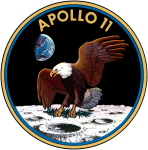 On July 20, 1969, just 45 years ago, Neil Armstrong became the first man to walk on the moon fulfilling President Kennedy’s dream. We have learned from those that were there that it was a hard and did require the best of our energies and skills. It was a challenge everyone accepted and made a success in seven years as the social and political turbulence of the 1960s were in high gear.
On July 20, 1969, just 45 years ago, Neil Armstrong became the first man to walk on the moon fulfilling President Kennedy’s dream. We have learned from those that were there that it was a hard and did require the best of our energies and skills. It was a challenge everyone accepted and made a success in seven years as the social and political turbulence of the 1960s were in high gear.
Space continues to be a fascinating topic as the “final frontier” of exploration. While there are areas of Earth’s oceans that remain unexplored, more people look to the stars as the next place for human exploration.
The politics and the politics of space have changed over the years but not the fascination of space exploration. One of the oldest science fiction franchises is based in space (Star Trek) and has been the inspiration for a lot of scientific development. While there were contractors building the parts NASA needed to fly into space, today there are companies that are building their own rockets and planning their own exploration.
Space has been a theme of coins, currency, and stamps around the world. An Internet search using the phrase “space themes on coins” can show a small sample of some of the coins that featured images commemorating space exploration. But the country that landed and walked on the moon first will not be amongst that list.
Although the United States has launched more rockets containing humans into space than any other nation and was the first to walk on the moon, the only tribute to space exploration was the use of the Apollo 11 insignia as the design by Frank Gasparo on the reverse of the Eisenhower and Susan B. Anthony dollars. For the Bicentennial issues in 1975 and 1976, an image of the Liberty Bell was superimposed over part of the image of the moon. This was the idea of Dennis R. Williams who won the design competition in 1974.
Given the remembrances of President Kennedy’s assassination and the celebration of the issuance of the half-dollar bearing his likeness, maybe it would be a nice idea to commemorate this achievement with a genuine United States commemorative coin.

John F. Kennedy speaking at Rice University where he gave his famous speech declaring the U.S. will land on the moon before the end of the decade.
All other images courtesy of Wikimedia Commons.

